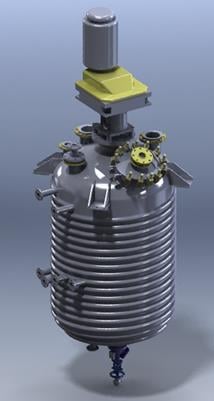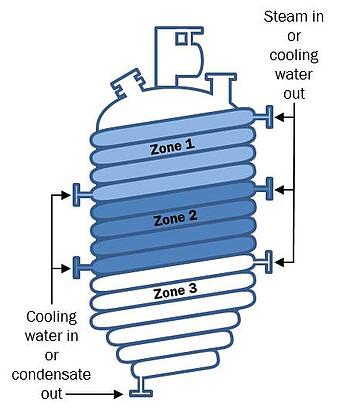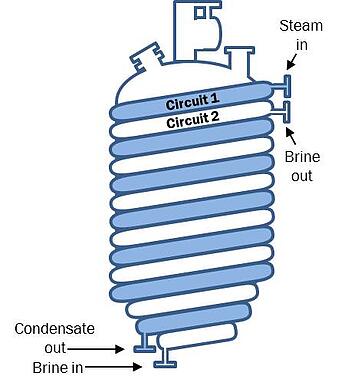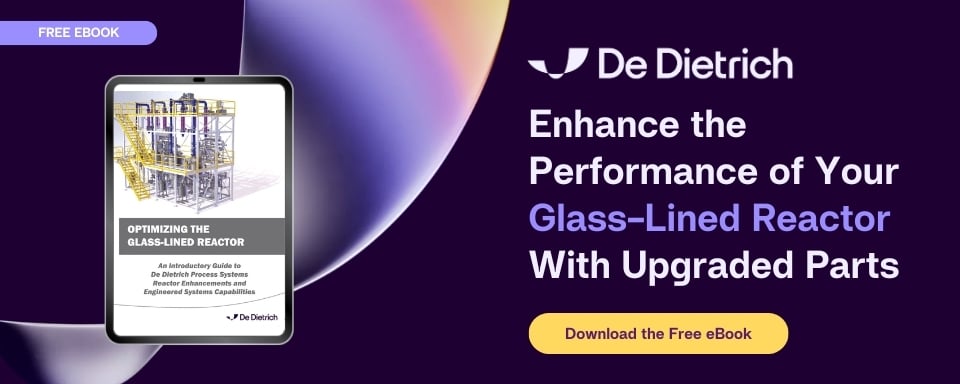Glass-Lined Reactor Jacket Selection
 You are probably well aware of the benefits of glass-lined reactors, most notably their chemical resistance and batch-to-batch cleanability. Despite the numerous advantages that make them essential to most pharmaceutical and fine chemical processes, glass-lined equipment has the drawback of relatively low thermal conductivity. To offset this shortcoming, jackets are used to assist in heating and cooling vessels. Heat transfer fluids are passed through these jackets to add or remove heat to and from the process.
You are probably well aware of the benefits of glass-lined reactors, most notably their chemical resistance and batch-to-batch cleanability. Despite the numerous advantages that make them essential to most pharmaceutical and fine chemical processes, glass-lined equipment has the drawback of relatively low thermal conductivity. To offset this shortcoming, jackets are used to assist in heating and cooling vessels. Heat transfer fluids are passed through these jackets to add or remove heat to and from the process.
Jacket performance is defined by three main parameters – the response time to modify the jacket temperature, the uniformity of jacket temperature, and the stability of jacket temperature. Combined, these all have a significant impact on the batch time and overall operating cost. The best option for your process, however, may not be the best for another so it’s important to know what your process objectives are before selecting a jacket type (e.g. if your process involves crystallization then you would be concerned with finding a jacket that enables fast temperature control response and uniform jacket heating/cooling). In this post we’ll talk about the two main jacket options for glass-lined reactors, including the good, the bad, and the “foul”.
Conventional Jackets
The single jacket, also known as a conventional jacket design, consists of an outer jacket which surrounds the vessel. Heat transfer fluid flows around the jacket and is injected at high velocity via nozzles. The temperature in the jacket is regulated to control heating or cooling.
The single jacket is the “traditional” or “standard” design for glass-lined reactors and has been around the longest. Tried and true, this solution does provide the best pricing for a cost-conscious purchaser but there are a number of limitations that need to be taken into account:
- Adjustment of fluid temperature in the cooling jacket can take many minutes on larger sized vessels.
- Variance in temperature can occur between the side walls and bottom of vessel.
- Formation of hot/cold spots at the jacket inlet points is prevalent due to the temperature control valve.
In short, if a more precise temperature control and distribution is important for your application, this probably isn’t the best option for you.
Half-Pipe Coil Jackets
The half-pipe or split-coil jacket (referred to by DDPS as HemiCoil®) consists of a welded half pipe that wraps around the outside of the vessel, creating a circular path for the heat transfer fluid to pass through. In a split-coil jacket, heating and cooling media flow through the pipe coils with high velocity and turbulence. As a result, film coefficients and heat transfer rates are higher than in conventional jackets. Vessel contents heat up and cool down, and the heat transfer circuit drains much faster-saving energy and reducing batch time.
With the split-coil design, only the diameter of the pipe - not the unsupported height of the inner vessel - must contain the jacket pressure. This permits the safe use of much higher pressures within the coils than is possible in conventional jacketing: 450 psig at 500°F is the standard operating limit.
The split-coil reactor design is ideally suited to multiple zone arrangements as well as superimposed parallel circuits. Separate zones (Figure 1) offer the best versatility and efficiency, reducing pressure drop while keeping overall heat transfer rates high. This arrangement is particularly applicable to heating steam/cooling water media. Additionally, the shorter runs of coil piping decrease the pumping energy required for fluid circulation.

Figure 1
Parallel circuits (Figure 2) promote most effective use of the heat transfer properties of incompatible media such as heating steam/cooling brine or heating oil/cooling water. The arrangements shown here are typical; depending on vessel size and process requirements, each circuit may be divided into two or more zones.

Figure 2
De Dietrich Process Systems can custom design coil patterns to suit your process needs. (In the diagrams above, pitch of coils is exaggerated for clarity).
A drawback to HemiCoil reactors is that they have to be welded to the vessel prior to glassing; conventional jackets can be added to a vessel at any point in production. Also, it will cost you approximately 30% to 35% more than the same reactor with a conventional jacket. In many instances this premium can be more than offset by decreased operating costs, increased heat transfer rates and better processing efficiency.
Combating Jacket Fouling/Contamination
From the standpoint of corrosion and deposition control, it would be ideal to have one fluid that could serve as both a heating and cooling medium. However, various heating and cooling mediums are often used, ranging from steam, water, glycol solutions and brines to a wide range of synthetic heat-transfer fluids. In a typical application, steam, cooling water and a chilled solution might all be used in the same jacket at different points in the reaction cycle. This is very efficient from a production standpoint, but potentially damaging in its effect on the jacket lining and vessel exterior.
The half-pipe jacket design is superior to conventional jackets in their ability to guard against contamination through the creation of multi-circuits. Because two or more completely separate circuits can be superimposed, incompatible heat transfer media can be used, speeding reaction time and avoiding risk of corrosion-accelerating cross-contamination. For example, you can run heating steam in one circuit and cooling brine or glycol/water in the other. With independent parallel circuits you can safely use combinations such as organic heat transfer media and cooling water, which could never be considered in a single circuit. You never need to worry about inadequate flushing or procedural error letting corrosion get a start, or about reconstitution of contaminated brines. An additional advantage: the split pipe coils form an efficient, environmentally favorable closed system, with low makeup requirements and less waste.
You can watch our video on “Optimizing the Glass-Lined Reactor” or read our Optimizing the Glass-Lined Reactor eBook to find out more about HemiCoil and OptiMix-HE, a wall-mounted baffle system that integrates the HemiCoil jacket to provide improved heat transfer and reduced processing times (as well as other upgrades available for glass-lined reactors).
Our Introductory Guide to Glass-Lined Equipment features a reference chart for determining the safe temperature range differentials between the product/vessel wall and thermal fluid.
